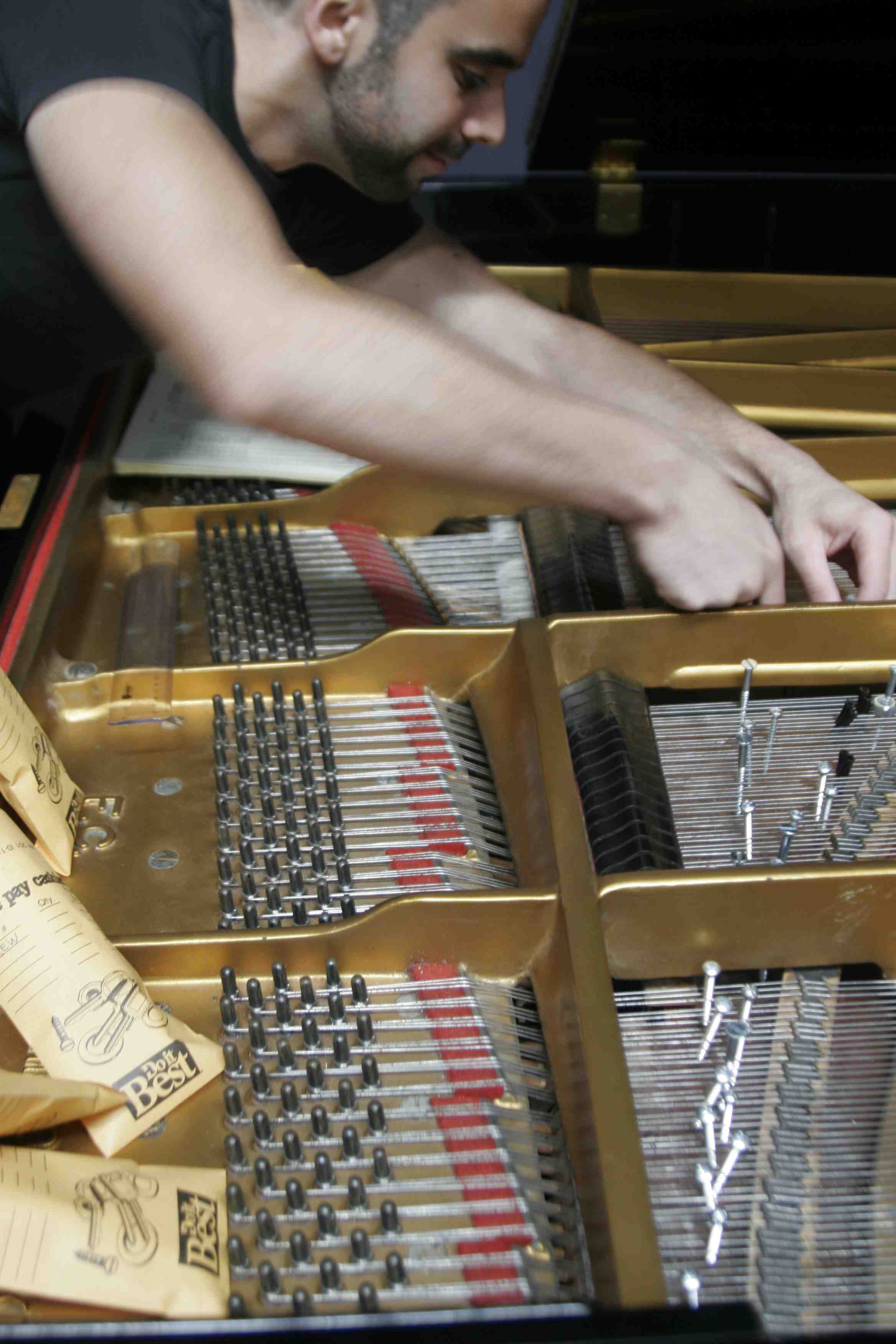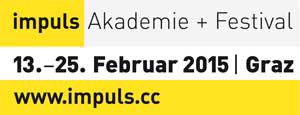Alles zum Thema:
2/2014 Shakespeare im zeitgenössischen Musiktheater

Staff favorites
John Cage on the Beach

Staff favorites
A prepared pianist reflects on Cage's sonatas and interludes
ESSAY
Adam Tendler
Pianist, composer, writer, curator, advocate. Tendler has toured throughout 2012 with John Cage’s complete Sonatas and Interludes to honor the composer’s centenary — including a New York City debut at the Rubin Museum and a performance at Symphony Space on the composer’s birthday.
A TSA agent holds up my translucent bag filled with screws, nuts, bolts, rubber tubing, shards of plastic, and latex gloves. "You working on a project, sir?" Standing in my socks, I dig through my carry-on and manifest the score for John Cage’s Sonatas and Interludes for prepared piano, opening to the table of preparations which lists the materials a pianist must insert between the piano strings along with exact measurements, down to the sixteenth of an inch, of where to insert them. I launch into the Homeland Security version of my master class on John Cage, starting with how in 1938 a choreographer named Syvilla Fort approached Cage, then a 26-years-old percussion composer, to create a new work for her dance company. Her studio, however, only had room for a grand piano, so Cage placed ordinary objects between some of the piano strings to transform its sound and create percussive effects. This "exploded keyboard" put "in the hands of a single pianist the equivalent of an entire percussion orchestra", and Cage spent over a decade exploring how with "just one musician you can really do an unlimited number of things."1 From incidental pieces with evocative titles like Totem Ancestor and Mysterious Adventure, Cage eventually delivered his hour-plus long sonic masterpiece, Sonatas and Interludes, now considered a landmark of modern music. The TSA agent waves me through. I grab my shoes.
I never met John Cage. He died when I was ten years old and no doubt still playing out of piano books with cartoons decorating the pages. I have the same relationship with Cage as I do any other nonliving composer from the twentieth century, with me as servant, scholar, detective, actor, ambassador, and him standing on a distant island like a myth, a legend of sorts accessible only through the surviving evidence, his scores, his lectures, the studies, the biographies, or the secondhand accounts from his friends and allies. I’m one degree too far away from the actual man. I wish I had anecdotes to tap into, memories of Cage the person that might somehow inform my musical decisions in the present. At a recent concert, a former neighbor of Cage’s brought me a photo she snapped of him at Black Mountain College, which until then had only existed as a slide. "He was smiling at me," she said. "And now I’m giving it to you." Such is my relationship with John Cage.
At other times, and perhaps because I have no choice, I value my limited scope and the inherent reverence it has produced. I hang on Cage’s every word as a kind of perplexing gospel. I swan dive into the rabbit hole of his work with a desire to collect everything I find and a passion to report it back to everyone I know. I disappear. In a recent concert, I played Sonatas and Interludes with all of the lights off except for a dim, dark blue that glowed faintly over the audience. People could barely see me; I could barely see the keyboard. All of us, in essence, had only the music to deal with. Many left in the first ten minutes.
But every performer has to become something of an authority on what they play, be it Schumann or Stockhausen. It comes with the job. In the summer of 2006, I’d just finished a fifty-state tour that landed me in Malibu, working for the summer in a veterinary clinic and watching my sister’s apartment while she, a showgirl at the time, performed in Las Vegas. I’d wanted to play Sonatas and Interludes since high school when I first heard the premiere recording by Maro Ajemian on a dusty old record in the back of my high school library. I used to call my friends into that otherwise abandoned study room to hear it, watching their reactions to the music as record spun. "That’s a piano!" I’d say. "Isn’t it cool?" Indeed, little has changed in my relationship to both modern music and my audiences.
In Malibu, I had only the silent keyboard I brought on my fifty-state tour to practice on. It was a gigantic apparatus, a keyboard ripped out of my late grandfather’s upright piano with a giant wooden box built around it. To some, this scenario might have seemed less than ideal, but for me the stars had aligned! I would use the silent keyboard to finally learn Sonatas and Interludes, a piece that I never would have wanted to learn on a conventional, unprepared piano anyway. Yes, I would practice the piece in silence, working backwards from the final measures of the piece, phrase by phrase, so that when I finally performed it, or practiced it in full, I’d always be playing into my familiarity. Every day I brought the score, all still notated in Cage’s exquisite but often cramped handwriting, to the veterinary clinic where I worked to study between admitting the cats and dogs of celebrities for their checkups. (For the fifty-state tour, I brought my scores to a construction site in a landfill where I worked.) I would first try to memorize a passage visually, finding anything in the music to which I could create a theoretical, intellectual association, and then I’d return at night to my silent keyboard to figure out the physical choreography. I built the piece this way, much like a rock climber establishes a safe point of contact before ascending to the next one. After nine months I could silently perform the whole piece from memory.
I lived in Texas by the time I finally visited a hardware store for the necessary preparation materials. Trusting the sales associate to give me the best match for Cage’s instructions, I showed him a list that, for all its exactitude, posed more questions than I’d bargained for. It turns out different people have different definitions for something as basic as a screw or a bolt, let alone a "small bolt", a "medium bolt", a "large bolt", a "long bolt", or a "furniture bolt", all of which Cage requires and trusts us to know the difference between, yet he provides no dimensions or diagrams, no explanation of what he means. Cage left the specifics of these materials, along with "Rubber" and "Plastic", to the performer’s discretion, and one can only gauge their effectiveness by, to use his own words, "trial and error".2
"Each time the Sonatas and Interludes are being played they sound differently", he said in a 1988 interview, forty years after their completion. "For one thing, the hardware that I used to put into a piano no longer exists. That was classical hardware and there were sizes of screws that don't exist anymore, and I think also the metals that used to be used to make screws are not used anymore. Also each piano is different from another. I became very sensitive to that. So instead of being annoyed by all those changes I accepted them; it's a part of the experience of moving from control to acceptance of what happens, and that also means the acceptance of chance operations—the whole thing of moving from composition as the making of choices to composition as the asking of questions."3
I now have three versions of every material, which I freely exchange depending on the piano and its level of cooperation. Cage said he chose his sounds "as one looks for shells on the beach", and I think a pianist should follow suit.4 I treat each note like its own individual instrument, and it takes me about two hours to get everything right. If it all sounds a bit intuitive, I assure you it is, but keep in mind that at the time of Sonatas and Interludes, John Cage still functioned very much as an intuitively expressive composer, still a romantic, of sorts, looking for interesting sounds to express a rather modest range of emotions and states.
For Sonatas and Interludes, Cage, who had just begun dabbling in philosophies of the East, applied the concept of rasa, a Hindu aesthetic theory that divides human emotion into eight permanent states; the heroic, erotic, wondrous, mirthful, sorrowful, fearful, angry, and odious, with all eight sharing a common tendency toward tranquility. Working in his "new apartment on the East River in Lower Manhattan, which turns its back to the city and looks to the water and the sky", Cage spent two years working on the piece.5
In yet another marriage between East and West, Cage structured each sonata – there are sixteen and all, with four interludes – using the strict binary form employed by Italian keyboard composer Domenico Scarlatti (1685-1757) in his over 500 keyboard sonatas. The Scarlatti sonata structure typically involves two repeated sections of music, each relatively equal in length (AABB). Cage follows the form in every sonata – one can actually hear it if they pay attention – yet he also obscures it occasionally though false repeats, unequal section lengths, and unrepeated introductions and transitions and epilogues, for starters, effectively disguising a meticulously constructed and conventionally notated score in an Eastern-inspired soundscape that sounds at once improvised, meditative, and startlingly new to this day.
After the premiere of Sonatas and Interludes, the New York Times called Cage "one of the country’s finest composers" and the prepared piano "vindicated musically." The work’s success served as a kind of springboard from which Cage seemed to abandon nearly all his previous methods of composing – many think of Sonatas and Interludes as a kind of encapsulation of Cage’s previous compositional approaches – in search of a higher compositional purity. Chance. Within four years he presented 4’33” to an unsuspecting planet still reeling from its impact sixty years later.
I suspect Cage attributed the popularity and longevity of Sonatas and Interludes to its usefulness, that people could use it more conveniently in a concert hall than his other music. But for Cage, a composer who spent his life exploring new ways to hear, create, and view music, it bothered him that audiences tended to prefer his earlier work, Sonatas and Interludes included, over his newer experiments which he considered so crucial and exciting. "It’s what I was doing ten years ago", Cage said of the prepared piano in a 1961 interview. "The public is always ten years behind."6
As Cage matured, the present moment became an increasingly crucial source for musical excavation. The results typically aroused confusion, outrage, and even abuse from performers. Still today, twenty years after his death, musical establishment largely grapples with Cage’s legacy, continuing to dismiss his contributions as the quirky, unreasonable, and dangerous musings of a radical mind. This is easier, of course, than actually reconciling musical history with a composer who changed it time and time again. Cage liberated his own music from the sentimentality of his personal preferences –some of his tonal music from the forties sounds borderline new-age – and quietly yielded authority to the universe, transforming his role of composer-as-dictator into something more along the lines of composer-as-mediator, or facilitator, or even participant, revolutionizing the dichotomy between creator and performer and audience. He created, to think of it visually, elaborate frames for space and time. Windows.
In 1957's Experimental Music, Cage wrote: "And what is the purpose of writing music? One is, of course, not dealing with purposes but dealing with sounds. Or the answer must take the form of paradox: a purposeful purposelessness or a purposeless play. This play, however, is an affirmation of life – not an attempt to bring order out of chaos nor to suggest improvements in creation, but simply a way of waking up to the very life we're living, which is so excellent once one gets one's mind and one's desires out of its way and lets it act of its own accord."
Sonatas and Interludes has become something of a modern classic over the last sixty-four years, with performances around the globe and hosts of recordings (including a free one of mine available through my website, adamtendler.com). But don’t be fooled. It remains one of the most uncompromising pieces in the literature. A complete performance takes listeners on a seventy-minute journey, at once thrilling, peaceful, and unsettling. It takes its time, has repeats in all but two movements, and requires listeners to abandon their expectations of what the music should do and forces them surrender to it on its own terms. (Could we also not say the above about Schubert?) It still has the potential to turn any audience into a kind of hung journey. A review from a performance I played in one of the country’s premiere contemporary arts festivals reported, "Many in the small audience visibly enjoyed it; others left long before its completion."
I’ve also had standing ovations, audience members who could barely contain their excitement afterward, and others who had to leave the hall in tears. Almost everywhere, though, people are surprised. Surprised, for lack of better words, that they liked the piece, that it moved them, that John Cage could compose something they understood on a wordless, un-hummable, emotional level. It shifts people through slow, deliberate movement, much like a yoga session.
The year he completed Sonatas and Interludes, Cage wrote: "Each one of us must now look to himself. That which formerly held us together and gave meaning to our occupations was our belief in God. When we transferred this belief first to heroes and then to things, we began to walk our separate paths. That island...to which we might have retreated to escape from the impact of the world, lies, as it ever did, within each one of our hearts. Towards the final tranquility, which today we so desperately need, any integrating occupation – music is only one of them – rightly used can serve as a guide."7
Like any great work of art, Sonatas and Interludes invites us to go deeper with each visitation. I hear something new with every performance and inevitably gain a new insight into how to better express the work next time. I’ve been touring with it for five years, and yet it continually humbles me with its technical and expressive challenges, and when it ends I feel ever more bonded with the audience who shared in the journey and the composer who drew us the map. In the final passage, a plateau of silence marked by soft repeated gongs, a plaintive, falling melody, and a stepwise sequence that rises, I can only imagine, "towards that final tranquility", I return to the Malibu apartment where I first spent my summer with Sonatas and Interludes. I smile. I think of the first night I sat before my silent keyboard with equal faith in love and miracles, and I could cry.
LINK:
Adam Tendler live in Maui: John Cage's Sonatas and Interludes for prepared piano. Free Download
- John Cage and Daniel Charles, For The Birds: John Cage in Conversation with Daniel Charles. (London: Marion Boyers, 1981), 38
- John Diliberto, "Conversations with Cage", Electronic Musician, March 1988
- Diliberto, "Conversations with Cage"
- Diliberto, "Conversations with Cage"
- John Cage, "A Composer’s Confession", address given before the National Inter-Collegiate Arts Conference, Vassar College, Poughkeepsie, New York, 28 February 1948
- clipping from unidentified Montreal newspaper, "Composer Here for Concert", Music Library, Northwestern University Library, Evanston, IL
- Cage, "A Composer’s Confession"





